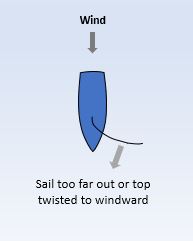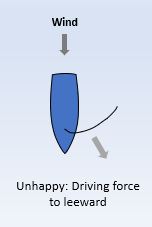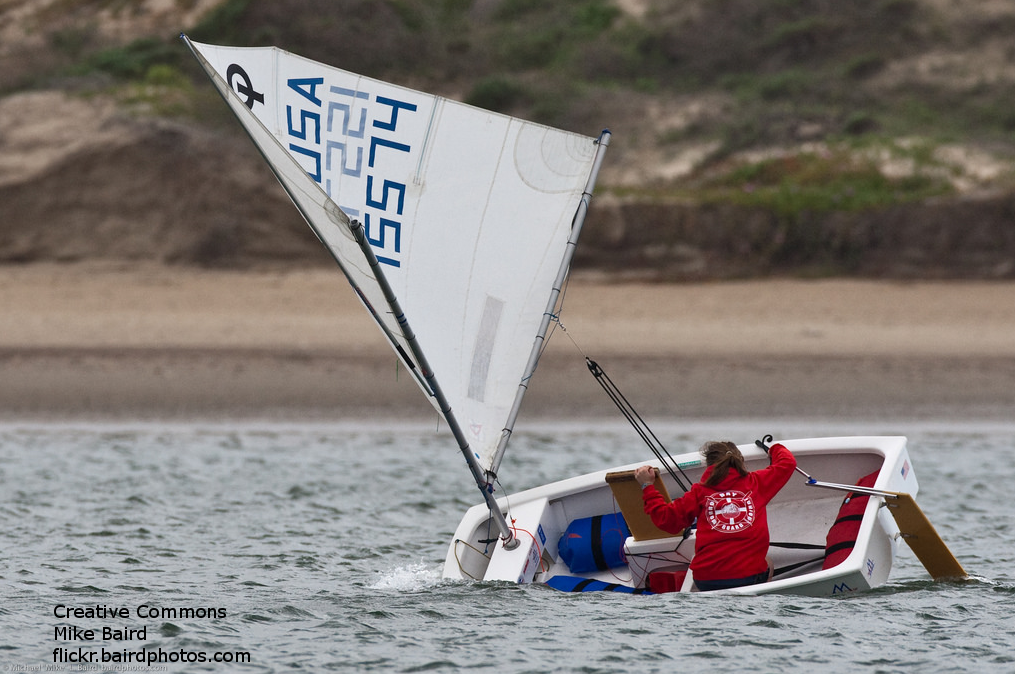Here’s Part 2 of our list of capsize causes and solutions for small boat sailors. In Part 1, we covered upwind situations related to too much heeling force and not enough righting moment. In this part, we’ll talk about off-wind balance. In Part 3, we’ll talk about sailing in waves and avoiding other boats
Off-wind capsizes occur because the boat is harder to balance against changes, especially when going dead downwind in a breeze. Consider the differences between upwind and off-wind sailing.
- Upwind, the heeling force is always to leeward, so you’re facing a one-dimensional situation. Off the wind, especially dead downwind, the direction of the heeling force can change rapidly.
- Upwind, you can reduce the heeling force by easing the sheets, depowering, or heading up. Off the wind, these techniques don’t always work.
Off-wind balance issues and capsizes result from one or more of the following causes:
- Unstable/unbalanced sail trim
- Improper steering
- Wrong board position
- Passive body position
The best resource we’ve see on this topic is a video from Rooster Sailing’s Steve Cockerill, which we captured in our post on Gain Dinghy Handling Skills. It’s 45 minutes long, but well worth watching.
Unstable/Unbalanced Sail Trim
Unstable sail trim – death roll
The dreaded death roll begins when the heeling force changes rapidly from leeward to windward. Here’s the typical sequence:

- Boom is out 80-90 degrees in heavy breeze. The top of the sail projects at 90 degrees to the boat or slightly forward of 90 degrees due to wind pressure. Crew weight is to windward to heel the boat and balance the overall force of the sail.
- A puff pushes the top of the sail further forward of the mast, which pushes the mast to windward. With no crew weight to leeward, the boat rolls quickly to windward. If the puff is big enough, the boat can death roll immediately.
- If the crew responds by shifting weight in, this accentuates the roll back to leeward when the puff diminishes. In gusty winds, the crew is unable to keep up, resulting in oscillations that eventually become too big to control.
Don’t let the top of the sail go too far forward of the mast. This happens for two reasons:
Too little vang
With too little vang, the upper leech is loose and will move forward quickly in a puff. To prevent this, add vang as the breeze builds. However, with too much vang, you can’t steer up and down in waves, because the top of the sail becomes unforgiving.
Sail too far out
If the sail is out too far, you get the same effect as too little vang. You can mitigate this by sheeting in the main to keep the top of the sail from going too far forward. Hold one part of the sheet in your hand and trim quickly if the boat starts to death roll. However, if you sheet in too much, the lower sail will cause weather helm, which makes it harder to steer.
In waves, you probably want to avoid sailing directly downwind because of these limitations on your ability to steer through the waves.
Unbalanced sail trim – broach

Cockerill calls sails “unhappy” when they are over- or under-trimmed off-wind. An over-trimmed sail adds weather helm and makes the boat heel to leeward and round up in gusts. The extreme example of this is a broach: the rudder has too much pressure on it and stalls. The boat then rounds up broadside to the wind and capsizes.
An under-trimmed sail makes the boat heel to windward. This can lead to the death roll discussed above.

To prevent unhappy sails, find the right sail trim for the point of sail, so that the driving force of the sail is in line with the boat’s heading.
Improper Steering
Not steering for balance
Have you ever capsized in a gust when broad reaching, even though you eased the sails? In Chapter 24 of High Performance Sailing, Frank Bethwaite discusses explains how to “steer for balance.”

Bethwaite shows how a fast-moving boat rolls when steering. Powerboats and sailboats with their boards up roll into the turn, because the water piles up against the hull on the outside of the turn. Sailboats with boards down roll away from the turn, because the moving water pushes the board in the direction of the turn heeling the boat in the opposite direction..
Using this fact, one way to prevent a capsize when off-wind is to steer the boat under the rig. If the boat heels to leeward, steer down, toward the rig. If the boat heels to windward, head up. This may seem counter-intuitive, but it works!
Steering for balance will also make you faster in reaches. The effectiveness depends on how deep you are reaching, boat speed, hull shape, and how much board is showing. Experiment with your boat to find what works best.
Rudder-induced heel
The rudder does more than turn the boat. If the rudder is off center, the moving water pushes on the rudder to heel the boat, just like the force of the wind on the sails.
Think about this for a minute. If you were being towed with no sails and boards up, which way would the boat heel if you pushed the tiller to starboard? Answer: the rudder would move to the port side of the boat. The water would push against the rudder to push the port side of the boat down and lift the starboard side of the boat. The boat would heel to port. So, when you move the tiller, the boat heels in the opposite direction. Cockerill shows this with a model boat at 3:50 in the video.
This is the opposite effect of steering for balance, described in the previous section. Bethwaite calls it “anti-steer for balance.” It is most noticeable in lightweight boats like lasers when sailing directly downwind with the board up. In the video at 1:07, Cockerill shows how tiller movement contributes to death rolls. If the boat starts rolling to windward, pushing the tiller to leeward will amplify the windward heeling force.
Wrong board position
Board too far down – tripping over the board
If your board is too far down off-wind, besides the additional drag, you are more susceptible to broaching, discussed above. This is due to the additional weather helm and the tendency to roll to leeward when turning up.
Board too far up – no control
When sailing off-wind, it’s tempting to raise the board as high as possible to reduce drag. However, you need to consider two cautions:
- If your boards are too far up, the steering for balance technique discussed in the steering section above won’t work. Your turns will be wide and the boat will roll into the turn.
- Putting your board(s) down further can add roll stability in waves.
What’s the optimal MC Scow board position for sailing off-wind in breeze?
- In waves, our MC Scow experts recommend putting both boards down 1/4 to 1/3. See our post on Sailing Downwind in Waves for more.
- In flat water, one board down 1/4 to 1/3 is conservative. Try less board for more speed when you’re confident about preventing a capsize. Use more board when steering is important.
Passive Body Position
Balance changes quickly off-wind. If you’re not ready to move your body, you could be toast. Cockerill has a nice discussion on this at 8:06 in the video. He shows how passive body position leads to capsizes downwind.
Downwind in breeze is not a time to relax. To be ready to move, adopt some key readiness positions:
- Feet planted and leg muscles engaged. Even though you may be sitting, have your feet in a stance to let you move and stand or crouch quickly. Have your quads and hamstring muscles engaged.
- Shoulders out. If your weight needs to be out, lean out with your shoulders rather than moving your whole body out. It’s easier to adjust your weight by leaning in and out than by moving the whole body.


